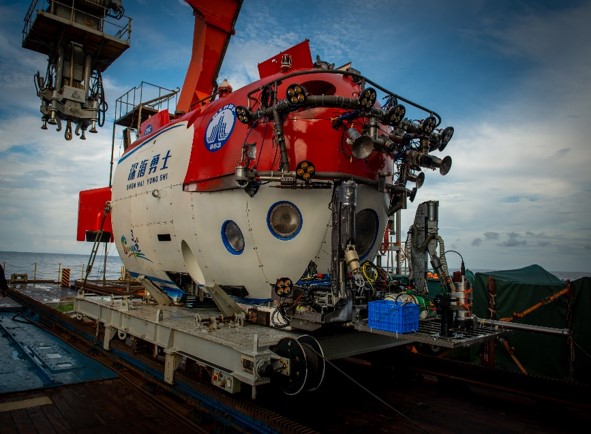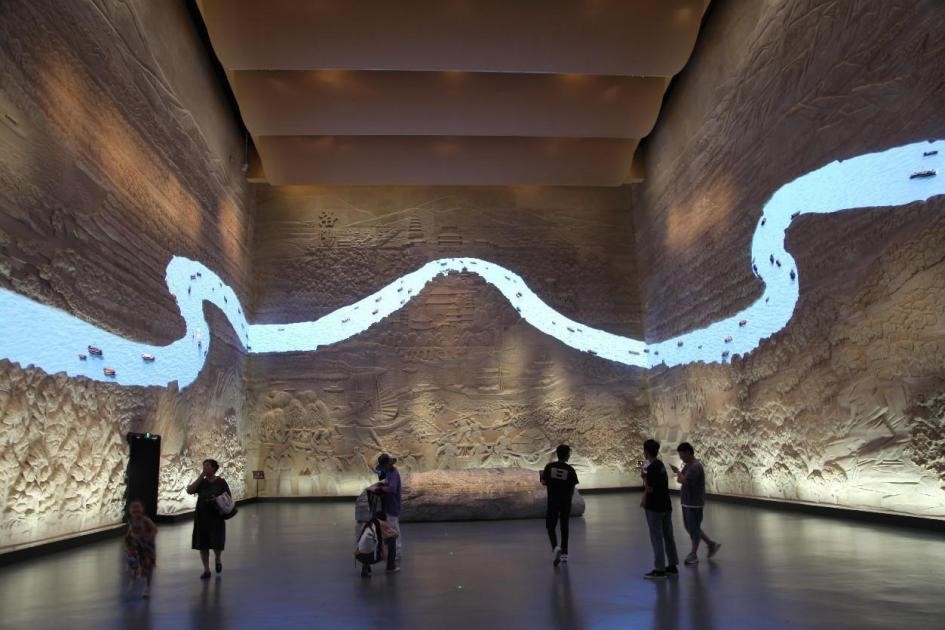To unlock door of history with key of technology
A world-class archaeological project has made new progress. Recently, China's National Cultural Heritage Administration announced the latest archaeological findings from the Northwest Continental Slope No. 1 and No. 2 Shipwreck sites in the South China Sea.
Underwater archaeology and cutting-edge technology have teamed up to crack open a "time capsule" that's been lying on the seabed for centuries, more than a kilometer below the sea surface.

Photo shows manned submersible Deepsea Warrior. (Photo provided by China's National Cultural Heritage Administration)
These long-lost treasures are finally seeing the light of day, stunning the world with their beauty. Each artifact tells its own tale of history while showcasing just how far technology has come.
"Retrieving" history from the vast, deep sea is no easy feat. In the past, when deep-diving technology was not this developed, China's underwater archaeology was mostly confined to coastal and shallow waters. Deep-sea archaeology seemed like an impossible mission.
But in August 2017, China's second manned deep-sea submersible, Deepsea Warrior, successfully completed its first manned dive, marking the beginning of China's deep-sea archaeology efforts.
The submersible played a crucial role in the recent archaeological survey of the Northwest Continental Slope No. 1 and No. 2 Shipwreck sites in the South China Sea. Its long baseline positioning system acted like a lighthouse, providing precise navigation. 3D laser scanners and high-definition cameras served as its "eyes," keenly capturing every detail in the murky underwater environment. The newly upgraded flexible robotic arms could steadily extract artifacts while preventing any damage.
Thanks to these technological advancements, archaeology has ventured into the blue depths, allowing us to reach deeper and further into the underwater world and explore the deep-sea imprints of Chinese civilization.

Deep-see submersible is operated by archeologists to retrieve artifacts. (Photo provided by China's National Cultural Heritage Administration)
Artifacts are the keys that unlock the memories of history. With the power of technology, more and more artifacts are being unveiled, revealing their mysterious stories.
From the Northwest Continental Slope No. 1 and No. 2 Shipwreck sites, pottery and porcelain pieces have been extracted. Some of them bear inscriptions such as "Fu (fortune)," "Zheng (righteousness)", "Taiping (peace)," and other information. These inscriptions not only serve as marks of their origin but also represent fragments of history. They reflect the daily lives of people from centuries ago and depicting the social landscape of that era. They narrate tales of joy and hardship, exploration and perseverance.
Each recovered artifact serves as crucial evidence. From the exported ceramics to the imported timber, and to the exotic Fahua pottery, the treasures found within the depths of the sea from the two sunken ships vividly depict the prosperous maritime trade during the mid-Ming Dynasty. They bear witness to the significant exchanges of trade and culture along the ancient Maritime Silk Road, showcasing the vibrant interactions between China and other nations.
Technology is expanding the boundaries of human cognition, enabling people to deepen their understanding of themselves through various means.
Carbon-14 dating has been utilized to establish a unified "time scale" for comparative research on different cultures, types, and archaeological sites, and ancient DNA studies were conducted to comprehensively comprehend the migration processes and social forms of ancient populations. Besides, organic residue analysis is used to understand the processing and utilization levels of organisms by our ancestors.

A motion mural is exhibited at the Sui-Tang Dynasties Grand Canal Cultural Museum in Luoyang, central China's Henan province. (People's Daily Online/Sun Jihu)
By harnessing technology effectively, archeologists can bring to light and revive the glory of those civilizations that have been buried by thick soil or submerged in seawater for thousands of years, allowing them to "speak" once again.
Technology is also breaking down barriers that once stood between ordinary viewers and the cultural relics. Virtual reality, augmented reality, holographic projection, artificial intelligence, and other technologies are increasingly being applied in the field of cultural heritage.
For example, the new building of the Sanxingdui Museum in southwest China's Sichuan province employs naked-eye 3D technology to recreate the archaeological site, allowing visitors to witness the moment when the relics were unearthed. The Grand Bao'en Temple Heritage Museum in Nanjing, east China's Jiangsu province has developed a metaverse program, enabling visitors to explore the Grand Bao'en Temple back in the Ming Dynasty (1368-1644).
Modern technology allows historical scenes to transcend time and space. Visitors can gain a more intuitive understanding of the value of cultural relics and experience the charm of culture and the profoundness of history. Only when cultural relics enter people's lives and hearts in a more dynamic way can their vitality be sustained.
Archaeology serves the purpose of decoding the past and also embarking on the journey towards the future. By using the key of technology to unlock the door of history, people will be able to better trace the origins of Chinese civilization and continuously expand the historical memory of human civilization.
Photos
Related Stories
Copyright © 2024 People's Daily Online. All Rights Reserved.









